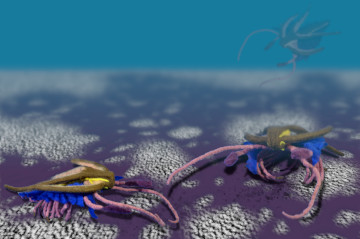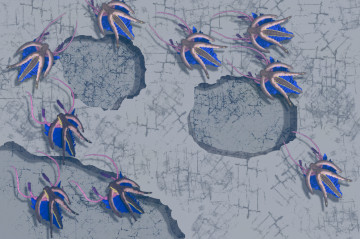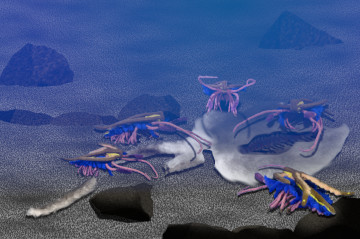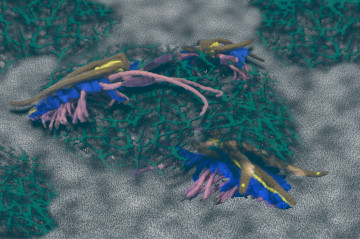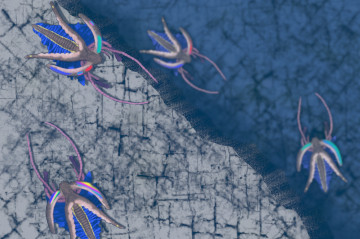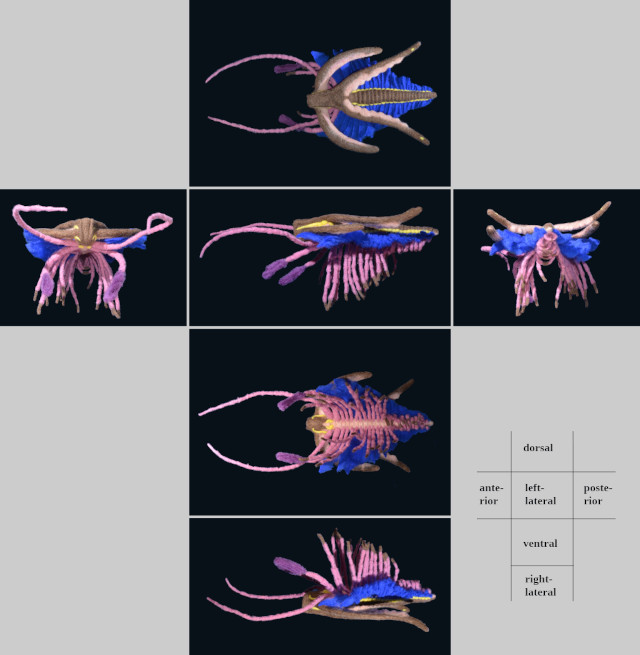Marrella splendens
Marrella splendens is a member of the Burgess Shale fauna of the Mid Cambrian, and an extinct species of the arhtropods 1). Over 25,000 specimens of Marrella have been corrected 1). Marrela is the most common and numerous marine arthropod in the Burgerss Shale fauna 1), 5). The affinity of Marrella is still uncertain 4).
The head area of Marrella is covered by a head shield with two pairs of prominent spines almost as long as the length of the body. One projects to backwards from the sides of the shield, another extends and bifucates to backwards from the posterior margin of the shield 5). A pair of long antennae and a pair of paddle- or brush-like appendages are extended from the ventral side of the head. The second pair seems as swimming appendages 2), 5).
The body possess 26 segments and each segment bears a pair of biramous appendages. The exopod (outer branch of biramous appendage) has a gill with long filaments, and endopod (inner branch) is a walking branch. The endopods of the posterior twelve segments extend toward the inside forming a net-like structure below the body 5).
The body length of Marrella is a large range from 2.4 to 24.5mm in length. The more large one possesses the more body segments, suggesting that the segments of the body increase with growth or developent 2).
The specimen fossilized in the midst of the moulting has been found and reported, confirms that the ecdysis of arthropod had already occurred in the early stage of their evolution 1).
The Cambrian was a unique period when the eyes evolved, and in such period, Marrella was surely preyed on by other eye-bearing arthropods such as Anomalocaris and Opabinia 3). The iridescent colors of Marrella may have acted as warning coloration (aposematism) to deter such eye-bearing predators 3).
In this felting Marrella, the location and shape of mouth is based on speculation. Many arthropods use hemocyanin as a respiratory pigment instead of hemoglobin, so I made the gill of this felting animal blue decisively.
created in September 2016.
References :
- García-Bellido DC, Collins, DH (2004) Moulting arthropod caught in the act. Nature 429:40. (DOI:10.1038/429040a.)
- García-Bellido DC, Collins, DH (2006) A new study of Marrella splendens (Arthropoda, Marrellomorpha) from the Middle Cambrian Burgess Shale, British Columbia, Canada. [abstract] Can. J. Earth Sci. 43(6): 721-742. (DOI:10.1139/e06-012.)
- Parker AR (1998) Colour in Burgess Shale animals and the effect of light on evolution in the Cambrian. Proc. Biol. Sci. 265(1400): 967-972. (DOI:10.1098/rspb.1998.0385.)
- Siveter DJ, Fortey RA, Sutton MD, Briggs DEG, Siveter DJ (2007) A Silurian ‘marrellomorph’ arthropod. Proc. R. Soc. B 247:2223-2229. (DOI:10.1098/rspb.2007.0712.)
- Marrella splendens -The Burgess Shale (Royal Ontario Museum)

